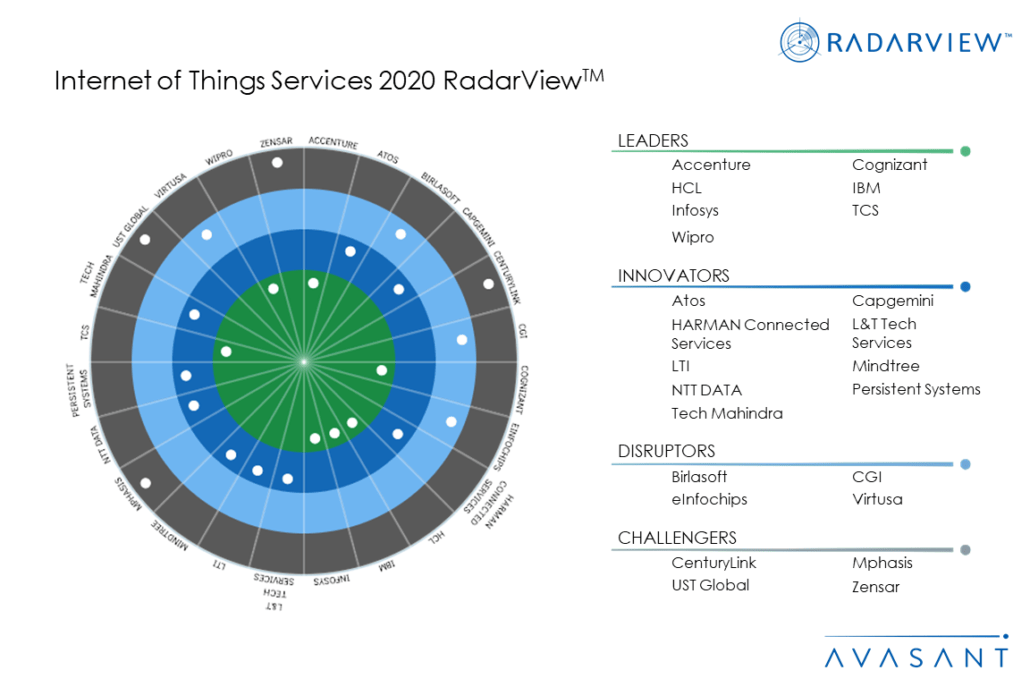The number of Internet of Things (IoT) projects is expected to grow in the near future as technologies that rely on rapid data collection from IoT devices, such as real-time analytics and artificial intelligence (AI), become more mainstream. Large-scale adoption of edge computing and the advent of 5G connectivity have disrupted the IoT market across three areas — connectivity, data, and security.
Avasant’s new Internet of Things Services 2020 RadarView™ report is a comprehensive, deep-dive study of the IoT market that informs enterprises about new developments and best practices in the space. It highlights Avasant’s viewpoint on the direction of the industry over the next 12 to 18 months and also provides a granular understanding of key IoT service providers.
Avasant evaluated 44 providers using a rigorous methodology across three key dimensions: practice maturity, investments and innovations, and industry development. Of the 44, 24 are recognized as having brought the most value to the market over the last 12 months.
The RadarView methodology recognizes service providers in four categories:
-
- Leaders: Accenture, Cognizant, HCL, IBM, Infosys, TCS, Wipro
- Innovators: Atos, Capgemini, HARMAN Connected Services, L&T Tech Services, LTI, Mindtree, NTT DATA, Persistent Systems, Tech Mahindra
- Disruptors: Birlasoft, CGI, eInfochips, Virtusa
- Challengers: CenturyLink, Mphasis, UST Global, Zensar
These four categories are illustrated in Figure 1 from the full report (click to enlarge):

“As IoT technology advances, business leaders are having to more quickly develop their business and operating models,” said Avasant Senior Analyst Amrita Keswani. “They need to select service providers that understand the challenges of their IoT journey and enable their business and operating models to align with customer expectations today and also to be future-ready.”
The report includes recommendations for enterprises to most effectively adopt IoT technology:
- Develop clear strategies and operational plans to become 5G-ready.
- Assess whether the business is constrained by limited bandwidth and slow data transfer. If it is, then study use cases that can create business value using 5G.
- For planning and budgeting, take note of the systems that are performing adequately at lower bandwidths. Conduct a comprehensive audit of existing IT infrastructure, hardware, and software that require upgrades or replacements for 5G.
- Use cloud and telecom provider partnerships to build 5G edge solutions.
- Telecom providers such as Verizon, AT&T, and Vodafone are collaborating with cloud providers such as AWS, Google Cloud, and Microsoft Azure for 5G edge innovation.
- The combined capabilities of telecom and cloud providers will enable enterprises to speed up data communications and processing by building ultra-low latency 5G edge solutions.
- Innovate with service providers to leverage their IoT expertise.
- Sixty percent of service providers have significantly invested in co-innovation by building business labs, centers of excellence, and programs to jointly develop IoT solutions with their clients.
- Organizations should collaborate and co-develop IoT solutions with service providers to gain access to their IoT capabilities.
The full report also features detailed, comprehensive RadarView Profiles of the top 24 IoT service providers, along with their assets and experiences in enabling customers’ IoT journeys. The report shows how the service provider landscape has evolved, not only in terms of categorization but also in the way they are investing in technology development, and human capital, along with their co-innovations with their customers.
This Research Byte is a brief overview of the full Internet of Things Services 2020 RadarView™ report. The full report is available at no charge for Avasant Research subscribers, or it may be purchased by non-subscribers directly from our website (click for pricing).

